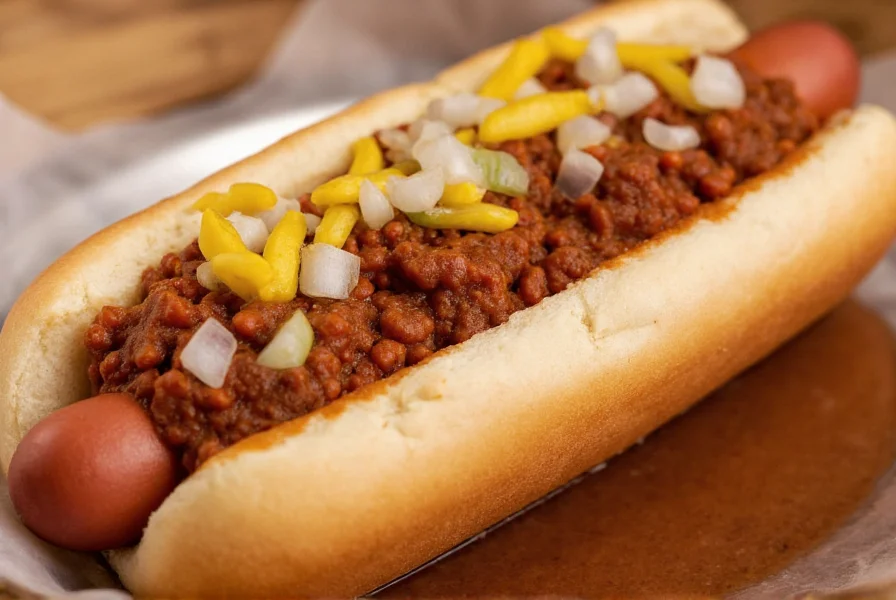When you bite into a classic Detroit chili coney, you're experiencing over a century of American culinary history. This iconic dish features a natural-casing hot dog nestled in a soft steamed bun, generously covered with a rich, meaty chili sauce made from ground beef, tomato sauce, and warming spices like cumin and chili powder. The trifecta of toppings—meat chili, diced white onions, and yellow mustard—creates a perfect balance of savory, sweet, and tangy flavors that defines the authentic coney experience.
The Origins of Detroit's Signature Dish
The chili coney emerged in early 1900s Detroit, created by Macedonian and Greek immigrants who adapted their traditional recipes to American ingredients. American Coney Island and Lafayette Coney Island, both opened around 1917 in downtown Detroit, became legendary establishments that cemented the dish's place in regional cuisine. These immigrant entrepreneurs developed a unique chili sauce that differed significantly from its Cincinnati counterpart—focusing on meatiness rather than sweetness, and completely omitting beans which are common in other chili variations.

What Makes a True Chili Coney?
Authentic Detroit chili coney follows specific characteristics that distinguish it from imitations:
| Element | Authentic Detroit Style | Common Misconceptions |
|---|---|---|
| Chili Sauce | Meat-based with no beans, tomato paste base, medium spice | Bean chili or overly sweet sauce |
| Hot Dog | Natural casing beef hot dog | Skinless or chicken hot dogs |
| Bun | Soft steamed bun without grill marks | Toasted or grilled bun |
| Toppings | Chili, onions, mustard (in that order) | Cheese, ketchup, relish |
Detroit vs Cincinnati: Understanding Regional Variations
Many confuse Detroit's chili coney with Cincinnati chili, but they're distinctly different culinary traditions. Cincinnati chili features a thinner, sweeter sauce often served over spaghetti or hot dogs (called "coneys" there too), typically with cheese. Detroit's version focuses on the meat chili's robust flavor without sweetness, never includes beans, and maintains the specific topping sequence of chili-onions-mustard.
The spice profile also differs significantly. Detroit coney sauce emphasizes cumin, garlic, and black pepper with moderate heat, while Cincinnati chili incorporates more Mediterranean spices like cinnamon and allspice, creating a distinctive sweet-savory profile. Understanding these differences helps appreciate each region's unique culinary heritage when searching for authentic chili coney near me or trying to recreate the dish at home.
Traditional Preparation Methods
Making proper chili coney sauce requires attention to detail. The meat chili starts with browned ground beef, then incorporates tomato paste, beef broth, and a carefully balanced spice mix. Unlike many chili recipes, it never includes beans, and the cooking process focuses on developing deep meat flavors rather than vegetable components.
Professional coney makers maintain their chili pots in a state of perpetual service—"never taking the pot off the stove," as the saying goes. This continuous simmering allows flavors to deepen over time while maintaining the proper consistency. Home cooks can achieve excellent results by preparing the sauce a day ahead, as the flavors improve with resting time.

Cultural Significance in American Food History
The chili coney represents an important chapter in American immigrant food adaptation. Macedonian and Greek immigrants transformed their traditional meat sauces into something uniquely American while maintaining their culinary heritage. These small diners became community gathering places, especially during Detroit's automotive industry boom.
Today, the chili coney remains a point of pride for Detroit residents and a must-try for visitors exploring Michigan's regional food specialties. The dish has influenced hot dog culture nationwide, with many regions developing their own interpretations while purists maintain that only the Detroit-style preparation qualifies as a true coney.
How to Identify Authentic Chili Coney Establishments
When searching for where to get the best chili coney, look for these markers of authenticity:
- Diners with decades of history, often family-owned for generations
- Menu featuring only coneys, hamburgers, and basic diner fare
- Visible chili pot simmering behind the counter
- Natural casing hot dogs that "snap" when bitten
- Steamed buns rather than toasted ones
- Chili served piping hot with visible meat texture
Avoid places that offer "gourmet" coneys with excessive toppings or unusual ingredients—the beauty of this dish lies in its simplicity and consistency. The best chili coney restaurants focus on perfecting the fundamentals rather than innovation.
Common Misunderstandings About Chili Cony
Several misconceptions cloud understanding of this classic dish:
- "All chili-topped hot dogs are coneys" – Only the specific Detroit-style preparation qualifies as a true coney
- "Coneys must include beans" – Authentic Detroit coney chili never contains beans
- "Cheese is traditional" – Cheese coney is a regional variation but not part of the original Detroit style
- "Cincinnati and Detroit styles are the same" – They represent completely different culinary traditions
Understanding these distinctions helps preserve the integrity of this American food tradition when exploring chili coney history and origins.
Creating Homemade Chili Cony: Essential Tips
While nothing compares to a classic Detroit diner experience, you can create respectable chili coney at home by following these guidelines:
- Start with quality natural-casing beef hot dogs
- Use a meat-focused chili recipe without beans
- Simmer the chili for at least 2 hours to develop flavors
- Steam the buns rather than toasting them
- Apply toppings in the traditional order: chili first, then onions, then mustard
- Serve immediately while all components are hot
For those seeking an easy chili coney dog recipe, remember that simplicity is key—focus on perfecting the chili sauce and maintaining the proper ingredient ratios rather than adding unnecessary elements.
Frequently Asked Questions
What's the difference between a chili dog and a chili coney?
A chili coney specifically refers to the Detroit-style preparation featuring a natural casing hot dog in a steamed bun with meat chili (no beans), diced onions, and yellow mustard. Regular chili dogs may use any type of chili (often with beans), different bun preparations, and additional toppings like cheese or relish. The term "coney" in Detroit denotes this specific preparation method and ingredient combination.
Does authentic Detroit chili coney contain beans?
No, authentic Detroit-style chili coney never contains beans. The meat chili is made exclusively from ground beef, tomato products, spices, and seasonings. This distinguishes it from many other chili varieties and from Cincinnati-style chili, which sometimes includes beans in certain preparations. The absence of beans is a defining characteristic of true Detroit coney sauce.
Why are the buns steamed for chili coney?
Steaming the buns creates the perfect texture for holding the hot chili without becoming soggy or falling apart. The soft, slightly moist bun provides a neutral base that complements the flavorful chili without competing with it. Unlike toasted buns which add their own flavor profile, steamed buns maintain the focus on the chili and hot dog. This preparation method has been standard in Detroit coney islands since their inception in the early 20th century.
What makes Detroit chili coney different from Cincinnati chili?
Detroit chili coney features a meatier, spicier sauce served exclusively on hot dogs with onions and mustard. Cincinnati chili is thinner, sweeter, and often served over spaghetti or hot dogs with cheese (called a "cheese coney"). Detroit's version never contains beans or sweet elements, while Cincinnati chili incorporates Mediterranean spices like cinnamon. The two represent completely distinct regional culinary traditions despite both being called "chili."
Can I make chili coney sauce ahead of time?
Yes, making chili coney sauce ahead of time actually improves the flavor. The sauce benefits from resting as the spices meld together. Professional coney makers often maintain their chili pots in continuous service ("never taking the pot off the stove"). For home preparation, make the sauce 1-2 days ahead, store it in the refrigerator, and reheat gently before serving. The sauce should have a thick but pourable consistency that clings to the hot dog without being runny.











 浙公网安备
33010002000092号
浙公网安备
33010002000092号 浙B2-20120091-4
浙B2-20120091-4